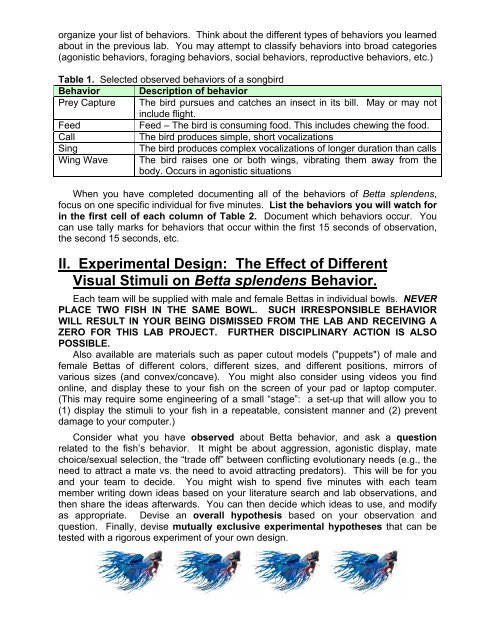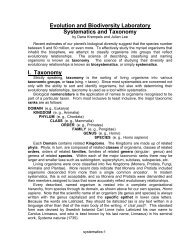Developing an Experimental Protocol: Agonistic Behavior in Betta ...
Developing an Experimental Protocol: Agonistic Behavior in Betta ...
Developing an Experimental Protocol: Agonistic Behavior in Betta ...
You also want an ePaper? Increase the reach of your titles
YUMPU automatically turns print PDFs into web optimized ePapers that Google loves.
org<strong>an</strong>ize your list of behaviors. Th<strong>in</strong>k about the different types of behaviors you learned<br />
about <strong>in</strong> the previous lab. You may attempt to classify behaviors <strong>in</strong>to broad categories<br />
(agonistic behaviors, forag<strong>in</strong>g behaviors, social behaviors, reproductive behaviors, etc.)<br />
Table 1. Selected observed behaviors of a songbird<br />
<strong>Behavior</strong> Description of behavior<br />
Prey Capture The bird pursues <strong>an</strong>d catches <strong>an</strong> <strong>in</strong>sect <strong>in</strong> its bill. May or may not<br />
<strong>in</strong>clude flight.<br />
Feed<br />
Feed – The bird is consum<strong>in</strong>g food. This <strong>in</strong>cludes chew<strong>in</strong>g the food.<br />
Call<br />
The bird produces simple, short vocalizations<br />
S<strong>in</strong>g<br />
The bird produces complex vocalizations of longer duration th<strong>an</strong> calls<br />
W<strong>in</strong>g Wave The bird raises one or both w<strong>in</strong>gs, vibrat<strong>in</strong>g them away from the<br />
body. Occurs <strong>in</strong> agonistic situations<br />
When you have completed document<strong>in</strong>g all of the behaviors of <strong>Betta</strong> splendens,<br />
focus on one specific <strong>in</strong>dividual for five m<strong>in</strong>utes. List the behaviors you will watch for<br />
<strong>in</strong> the first cell of each column of Table 2. Document which behaviors occur. You<br />
c<strong>an</strong> use tally marks for behaviors that occur with<strong>in</strong> the first 15 seconds of observation,<br />
the second 15 seconds, etc.<br />
II. <strong>Experimental</strong> Design: The Effect of Different<br />
Visual Stimuli on <strong>Betta</strong> splendens <strong>Behavior</strong>.<br />
Each team will be supplied with male <strong>an</strong>d female <strong>Betta</strong>s <strong>in</strong> <strong>in</strong>dividual bowls. NEVER<br />
PLACE TWO FISH IN THE SAME BOWL. SUCH IRRESPONSIBLE BEHAVIOR<br />
WILL RESULT IN YOUR BEING DISMISSED FROM THE LAB AND RECEIVING A<br />
ZERO FOR THIS LAB PROJECT. FURTHER DISCIPLINARY ACTION IS ALSO<br />
POSSIBLE.<br />
Also available are materials such as paper cutout models ("puppets") of male <strong>an</strong>d<br />
female <strong>Betta</strong>s of different colors, different sizes, <strong>an</strong>d different positions, mirrors of<br />
various sizes (<strong>an</strong>d convex/concave). You might also consider us<strong>in</strong>g videos you f<strong>in</strong>d<br />
onl<strong>in</strong>e, <strong>an</strong>d display these to your fish on the screen of your pad or laptop computer.<br />
(This may require some eng<strong>in</strong>eer<strong>in</strong>g of a small “stage”: a set-up that will allow you to<br />
(1) display the stimuli to your fish <strong>in</strong> a repeatable, consistent m<strong>an</strong>ner <strong>an</strong>d (2) prevent<br />
damage to your computer.)<br />
Consider what you have observed about <strong>Betta</strong> behavior, <strong>an</strong>d ask a question<br />
related to the fish’s behavior. It might be about aggression, agonistic display, mate<br />
choice/sexual selection, the “trade off” between conflict<strong>in</strong>g evolutionary needs (e.g., the<br />
need to attract a mate vs. the need to avoid attract<strong>in</strong>g predators). This will be for you<br />
<strong>an</strong>d your team to decide. You might wish to spend five m<strong>in</strong>utes with each team<br />
member writ<strong>in</strong>g down ideas based on your literature search <strong>an</strong>d lab observations, <strong>an</strong>d<br />
then share the ideas afterwards. You c<strong>an</strong> then decide which ideas to use, <strong>an</strong>d modify<br />
as appropriate. Devise <strong>an</strong> overall hypothesis based on your observation <strong>an</strong>d<br />
question. F<strong>in</strong>ally, devise mutually exclusive experimental hypotheses that c<strong>an</strong> be<br />
tested with a rigorous experiment of your own design.

















